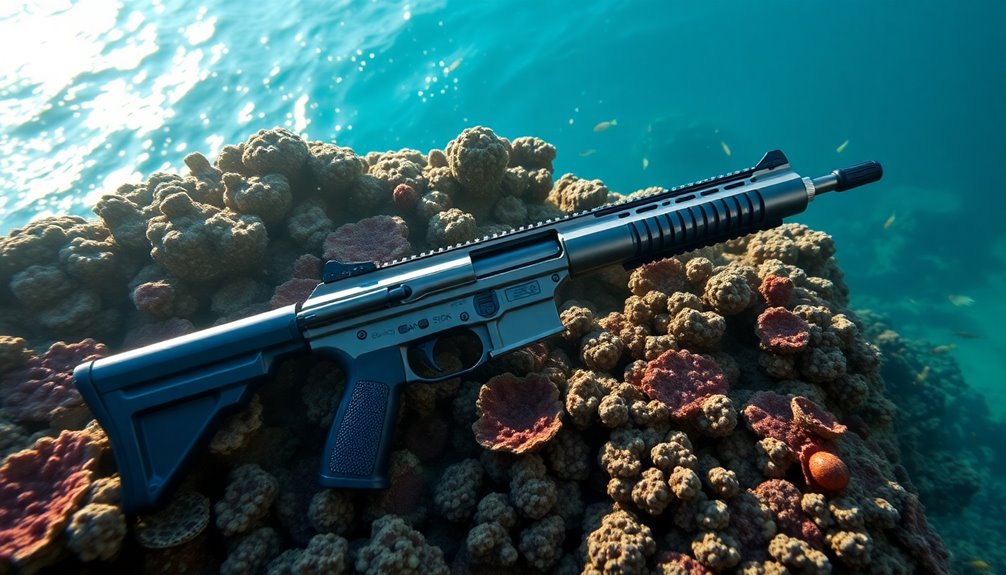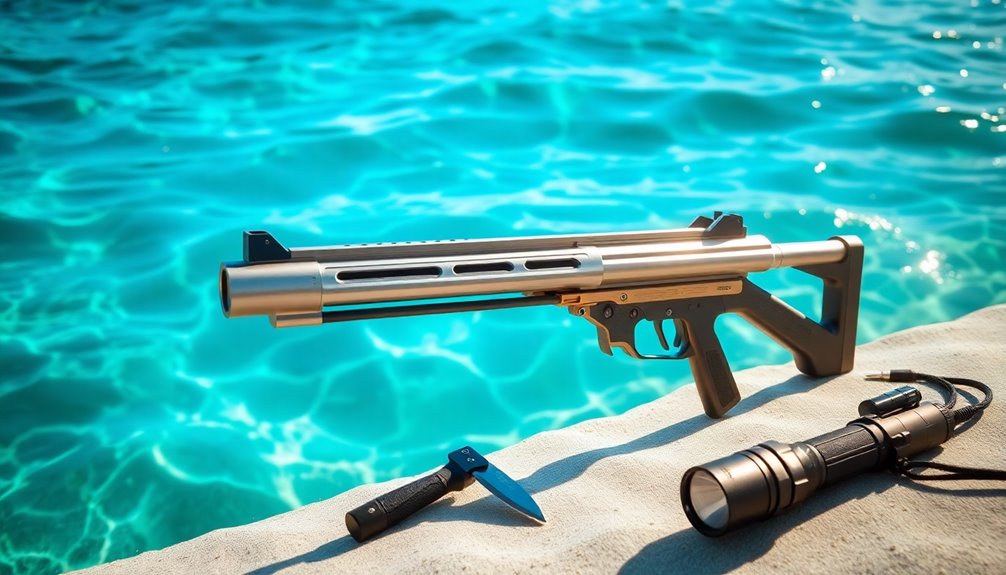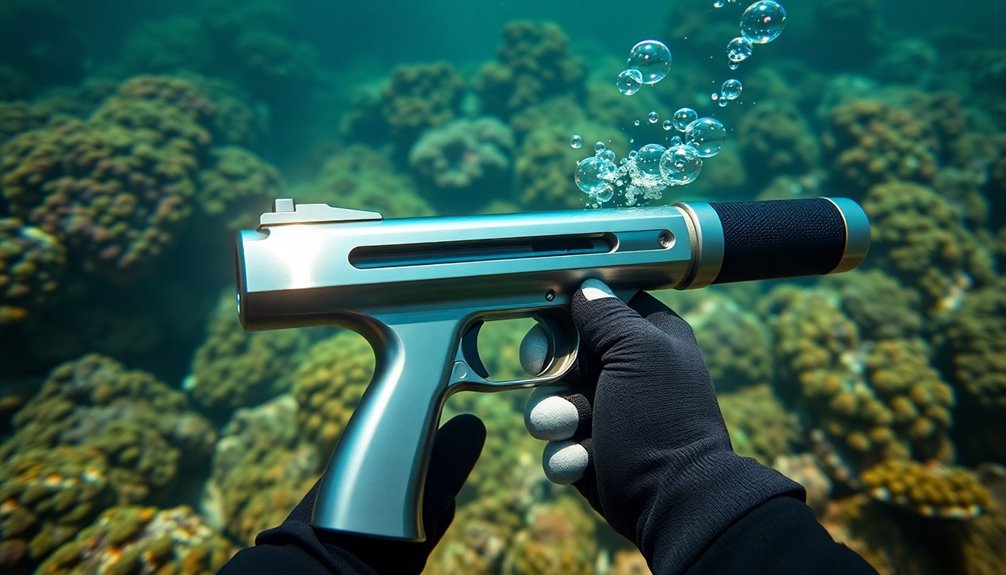A bang stick gun is your go-to tool for instant stopping power beneath the waves. This device delivers lethal impacts to deter aggressive marine life, especially sharks, using cartridges that ignite upon contact. Designed for easy maneuverability, it employs gas expansion for enhanced stopping force. Users report increased confidence in water, but proper training and safety measures are essential to avoid accidental discharge. Choosing the right cartridge can make a significant difference based on your underwater situation. Want to know more about its effectiveness and best practices? There's plenty more to explore about this unique underwater defense tool!
Key Takeaways
- Bang sticks provide instant stopping power against aggressive marine life, particularly sharks, with lethal gas expansion upon impact.
- They utilize 12-gauge shotgun shells, delivering significant tissue damage and rapid incapacitation of threats underwater.
- Proper shot placement is essential, with .223 caliber for most sharks and 30-06 for larger species to ensure effectiveness.
- Safety mechanisms and thorough training are crucial to prevent accidental discharges and ensure reliable operation.
- Local regulations may classify bang sticks as firearms; understanding legalities is vital for safe transportation and usage.
Overview of Bang Stick Guns

Bang stick guns are unique underwater defense tools designed to protect you from aggressive marine life, especially sharks. These specialized weapons employ a cartridge that ignites upon contact, utilizing gas expansion to deliver lethal impacts. This mechanism allows for significant tissue damage, making bang sticks effective for deterring threats beneath the waves.
Various models are available, including those that use 12-gauge shotgun shells, providing increased power and effectiveness in the underwater environment. However, it's vital to note that bang sticks are classified as weapons, and their legality varies by jurisdiction. You must be aware of local laws regarding their usage and transportation on boats.
While bang sticks can be a reliable means of defense, they come with inherent safety risks. Proper training and handling are important to minimize these dangers. Understanding how to safely operate a bang stick will guarantee that you can use it confidently in emergency situations without putting yourself or others at risk.
When venturing into waters that might host aggressive marine life, a well-trained user with a bang stick can enhance your safety and peace of mind.
Mechanism of Action

The mechanism behind a bang stick gun is straightforward yet effective, designed specifically for underwater defense. When you thrust the bang stick into a target, the impact activates the firing pin, igniting a shotgun shell or other cartridge. This triggers an explosion that produces a concussive force, incapacitating marine predators like sharks.
One of the standout features of the Seaway Bangstick is its use of gas expansion. Instead of relying solely on projectile impact, it employs six drilled ports that release massive gas clouds upon detonation, enhancing its stopping power.
This unique design also allows for customization, enabling you to choose cartridges that suit your underwater situations, such as powerful 12-gauge shotgun shells.
Safety is paramount, and the bang stick incorporates a safety mechanism, often a cotter pin, to prevent accidental discharge.
With lengths reaching up to 8 feet, the bang stick remains portable and easy to maneuver. Whether you’re diving or in a kayak, this effective tool provides peace of mind against potential threats lurking beneath the waves. If you’re in need of a reliable and compact self-defense option while in the water, the bang stick is a must-have. Its simplicity and effectiveness make it a valuable asset for any water enthusiast. If you want to learn more about essential water gear, check out the Beuchat watch review for a comprehensive guide to staying safe and prepared during your aquatic adventures.
Effectiveness Against Sharks

When faced with a shark encounter, a bang stick gun proves to be an effective deterrent, delivering immediate and lethal impact on large marine animals.
Utilizing gas expansion, it creates massive tissue damage upon detonation, incapacitating sharks swiftly. Proper shot placement is essential; a .223 caliber is sufficient for most sharks, while a 30-06 is recommended for larger species.
In tests conducted in shark-infested waters, sharks exhibited erratic movement and fled immediately after a bang stick was fired, showcasing its strong deterrent capability.
The design of the bang stick relies on concussive effects rather than traditional projectile force, making it a viable option for underwater defense against aggressive marine life.
This unique method of incapacitation can provide divers with a sense of security in potentially dangerous situations.
User Experiences and Feedback

When using a bang stick, your experience can vary widely; some find it a reliable tool against marine threats, while others feel uneasy about its safety.
Many users raise concerns about accidental discharge and the potential for injury, stressing the importance of training.
Despite these worries, many divers report feeling more confident in the water with a bang stick at hand, although they often recommend combining it with other defensive strategies.
Mixed User Perspectives
User experiences with bang sticks reveal a wide spectrum of opinions, highlighting both their potential benefits and drawbacks in marine environments. Many users find bang sticks effective for deterring marine predators, providing an immediate impact when needed.
However, concerns about their intimidation factor and the risk of accidental discharge can't be ignored. Proper training is essential; without it, users may mishandle bang sticks, leading to serious injuries.
Feedback indicates skepticism regarding the bang stick's reliability in emergency situations, particularly during sudden shark attacks. The speed of these encounters can render defensive tools ineffective, and some users report that the bang stick may not penetrate critical organs in larger sharks, raising questions about its practical utility.
Community discussions show a mixed sentiment about the necessity of bang sticks. While some divers advocate for them, others promote alternative defensive strategies and equipment, reflecting an evolving perspective on underwater safety.
Balancing the potential benefits with the inherent risks, it's clear that user experiences with bang sticks vary greatly, emphasizing the need for proper training and caution in their use.
Safety Concerns Highlighted
Many divers express significant concerns about the safety of bang sticks, particularly regarding the potential for accidental discharges.
Mishandling these devices can lead to serious injuries, reinforcing the need for thorough understanding of safety protocols. Recoil is another common issue; improper aim can create dangerous situations, especially near solid underwater structures.
To promote safe usage, consider these essential guidelines:
- Proper Training: Engage in thorough training sessions to understand the equipment fully.
- Slip-on Powerheads: Opt for slip-on powerheads to minimize accidental discharge risks.
- Regular Maintenance: Conduct consistent maintenance and inspection of your bang stick to guarantee reliable operation.
- Awareness of Recoil: Familiarize yourself with recoil dynamics to prevent mishaps during underwater activities.
Safety Precautions and Concerns

Guaranteeing safety when handling a bang stick is paramount to prevent accidents and injuries. Always keep your bang stick unloaded until you're ready to use it. This practice markedly reduces the risk of accidental discharges.
Utilize safety mechanisms, like cotter pins, to prevent unintentional firing, especially during transport or underwater activities. Proper handling is essential, so familiarize yourself with the equipment and its recoil to avoid injury.
It's important to undergo thorough training before using a bang stick; understanding your equipment will help guarantee reliable operation and enhance your safety. Regular maintenance also plays a crucial role—inspect your ammunition and seal cartridges to prevent malfunctions.
Additionally, consider using slip-on powerheads, which can enhance safety and reduce the risks associated with handling these devices.
Remember, the combination of proper handling, safety mechanisms, and ongoing training can greatly improve your safety while using a bang stick. Always prioritize these precautions to enjoy a safer experience beneath the waves.
Maintenance and Care Tips

Maintaining your bang stick is vital for guaranteeing its reliability and safety during use. Regular upkeep not only prevents malfunctions but also enhances your confidence while diving. Here are some key maintenance tips:
- Regular inspection: Check your bang stick for any signs of wear or damage, guaranteeing all parts function correctly.
- Ammunition care: Keep ammunition well-oiled to prevent corrosion. Regularly seal cartridges to maintain reliable performance.
- Waterproofing techniques: Use nail polish or hot wax on shotgun shells to enhance waterproofing, vital for underwater environments.
- Safe transportation: Always transport your bang stick unloaded. Store it securely in PVC pipes to prevent damage during transit.
Additionally, be cautious of recoil when aiming at solid objects underwater, as it can affect your aim and safety.
Comparisons With Other Defense Tools

When you compare bang sticks to traditional firearms, you'll notice their unique ability to deliver stopping power underwater without the need for precise aiming.
Unlike powerheads, which use a dart mechanism, bang sticks create a powerful gas expansion that can tackle larger marine threats more effectively.
Understanding these differences can help you choose the right tool for your underwater encounters.
Bang Stick Versus Firearms
In situations where marine predators pose a threat, many divers find themselves weighing their options between bang sticks and traditional firearms. While firearms might seem appealing, they quickly lose projectile speed and range underwater, rendering them ineffective.
In contrast, a bang stick utilizes a gunpowder cartridge to deliver immediate, lethal impact on aggressive marine life, ensuring reliability in aquatic environments.
Here's a quick comparison of the two:
- Reliability: Bang sticks are designed for underwater use, while firearms can malfunction.
- Lethal Impact: Bang sticks rely on gas expansion for damage, unlike firearms that depend on traditional projectile force.
- Quick Loading: Bang sticks allow for a rapid loading process, making them a practical last-resort defense tool.
- Legal Considerations: Bang sticks are often legally permitted on boats, whereas firearms face stricter regulations in many aquatic areas.
Ultimately, for underwater protection against marine predators, bang sticks present a more effective and practical option compared to firearms. Their unique design and functionality make them an essential defense tool for divers traversing potentially dangerous waters.
Powerheads Compared to Bang Sticks**
While bang sticks offer reliable protection against aggressive marine life, powerheads provide a different approach to underwater defense. A powerhead utilizes a dart and a two-line system for shooting and retrieving, allowing for precision targeting, which can be vital in certain hunting applications.
In contrast, bang sticks ignite cartridges upon contact, delivering an immediate deterrence through a concussive effect ideal for close encounters.
Both tools use cartridges, but their mechanisms and intended purposes differ markedly. Bang sticks are favored for their simplicity and effectiveness in deterring threats quickly, while powerheads excel in delivering controlled shots for more specific situations.
However, it's important to note that regulations surrounding powerheads can be stricter, as they're often classified similarly to sawed-off shotguns. This can limit their usage in certain areas compared to the more widely accepted bang stick.
Ultimately, your choice between a bang stick and a powerhead will depend on your needs. If you seek immediate deterrence against aggressive marine life, a bang stick is your best bet. For precision in hunting applications, consider the powerhead, keeping in mind the regulations that may apply.
Legal Regulations and Considerations

Understanding the legal regulations surrounding bangsticks is vital for anyone considering their use, especially in aquatic environments. These devices are classified as weapons, which affects their legal possession and use. The regulations governing bangsticks can vary considerably depending on your jurisdiction, so it's important to familiarize yourself with local laws.
- Classification: Bangsticks may be considered firearms in some regions.
- Transportation: Always transport them unloaded to avoid legal complications.
- Use Limitations: Their use is generally restricted during diving activities.
- Enforcement: Local sheriff's offices can provide clarification, though some officers may not be familiar with bangsticks.
Given these factors, you should always confirm the specific laws in your area before using a bangstick. This guarantees you're compliant with regulations and avoids potential issues with law enforcement.
Additionally, if you're considering using a bangstick in international waters, be extra cautious about the legality of carrying loaded underwater weapons. Knowledge of these regulations not only keeps you safe but also enhances your overall experience in the aquatic environment.
Shark Behavior Insights

Sharks often intrigue divers with their mysterious behavior, typically investigating rather than threatening. Most shark encounters occur at a distance, allowing you to appreciate their grace without feeling aggressive intentions.
While great white sharks are known for their ambush tactics from below, your safety can be influenced by visibility. Poor conditions often lead to increased caution among divers, but remember that experienced divers often report low concern regarding shark interactions.
In fact, many see these encounters as rare events rather than imminent threats. When you observe seals or sea lions, you may find they're generally harmless, and sightings of sharks tend to be infrequent.
Personal anecdotes from divers reveal the unpredictability of shark behavior, with sizes ranging from 6 to 20 feet. This variability can influence your perceptions of safety in the water.
Understanding shark behavior helps you navigate your experiences underwater. By recognizing that sharks are more inclined to investigate than attack, you can approach your encounters with a sense of curiosity rather than fear.
Embracing this perspective allows you to enjoy the remarkable beauty of the ocean's apex predators while maintaining a focus on your safety.
Recommendations for Divers

When you're using a bang stick, safety should always come first.
Make sure you're properly trained and understand how to handle the equipment to avoid accidents.
Additionally, familiarize yourself with effective usage techniques to enhance your safety and effectiveness in the water.
Safety Precautions for Divers
While diving can be an exhilarating experience, guaranteeing your safety is essential, especially when using equipment like a bang stick. Adhering to specific safety precautions can greatly reduce risks associated with underwater weapons. Here are some crucial tips to keep in mind:
- Keep your bang stick unloaded until you're ready to use it. This minimizes the risk of accidental discharge.
- Regularly inspect your bang stick and ammunition for any signs of wear or damage. Verify everything is in peak condition before each dive.
- Utilize slip-on powerheads with dual safety features. These enhance safety and prevent accidental firing, particularly in underwater environments.
- Familiarize yourself with legal regulations regarding bang sticks in your area to avoid any legal complications during your diving activities.
Additionally, maintain situational awareness while diving. If you encounter a shark, make sure to avoid panicking. Use calm movements to deter potential threats without relying solely on your bang stick.
Effective Usage Techniques
Using a bang stick effectively requires a solid understanding of both the equipment and the situation at hand. Always keep your bang stick unloaded until you absolutely need it, and load it only when necessary to minimize the risk of accidental discharge. Familiarize yourself with the safety features of your bang stick to prevent injuries from recoil or misfiring.
Proper shot placement is essential for effective usage; aim for important areas of larger marine animals to guarantee immediate stopping power. Misplaced shots can render the bang stick ineffective, so practice your aim whenever possible.
Regular maintenance is key—inspect your bang stick frequently, checking that cartridges are waterproofed and all components function dependably in emergencies.
Lastly, make certain you're aware of local regulations regarding bang sticks. Laws can vary greatly by region, and knowing the rules can help you avoid legal complications while assuring underwater safety. By following these guidelines, you'll enhance your confidence and effectiveness in using the bang stick while protecting yourself and respecting the marine environment.
Frequently Asked Questions
Are Bang Sticks Legal?
Are bang sticks legal? It really depends on where you are.
In many regions, they're classified as weapons, so their legality can vary greatly. You can often use them on boats, but you should check local regulations to make sure you're compliant, especially during transport.
Some areas allow bang sticks for subduing hooked sharks, but using them while diving might be illegal.
Always verify with local authorities to avoid any confusion or issues.
What Is the Difference Between a Powerhead and a Bang Stick?
When you think of underwater tools, it's easy to confuse a powerhead with a bang stick.
A powerhead fires a dart using a cartridge, designed mainly for fishing, while a bang stick relies on shotgun shells to deliver a concussive impact for defensive purposes.
Picture a sturdy barrel with a simple firing mechanism for the bang stick, compared to the more complex two-line system of the powerhead.
Both serve distinct roles in marine environments.
How Do Bangsticks Work?
Bangsticks work by utilizing a gunpowder cartridge that ignites upon contact with a target.
When you press it against a large marine creature, the ignition creates a powerful concussive force, delivering significant tissue damage. Instead of firing a projectile, it relies on this impact to incapacitate threats.
You'll find various models, often designed for durability and effectiveness, making bangsticks a unique tool for underwater encounters with large animals like sharks.
How to Use Powerhead Spearfishing?
To use a powerhead for spearfishing, first attach it securely to your spear shaft, making certain the cartridge is properly seated.
Check local laws, as powerheads may be considered firearms in some areas.
When aiming, focus on crucial areas of the target to guarantee a clean kill.
Regularly inspect and maintain your powerhead, confirming cartridges are waterproofed and in good condition for reliable performance during your underwater encounters.
Conclusion
In the depths of the ocean, the bang stick gun promises instant stopping power, but it's vital to remember that every action has consequences. While it offers a sense of security against shark encounters, it's important to respect these magnificent creatures and their environment. Misusing such tools can lead to unintended harm, not just to sharks but to divers too. Embrace the thrill of the ocean, but always prioritize safety, understanding, and coexistence over aggression.










